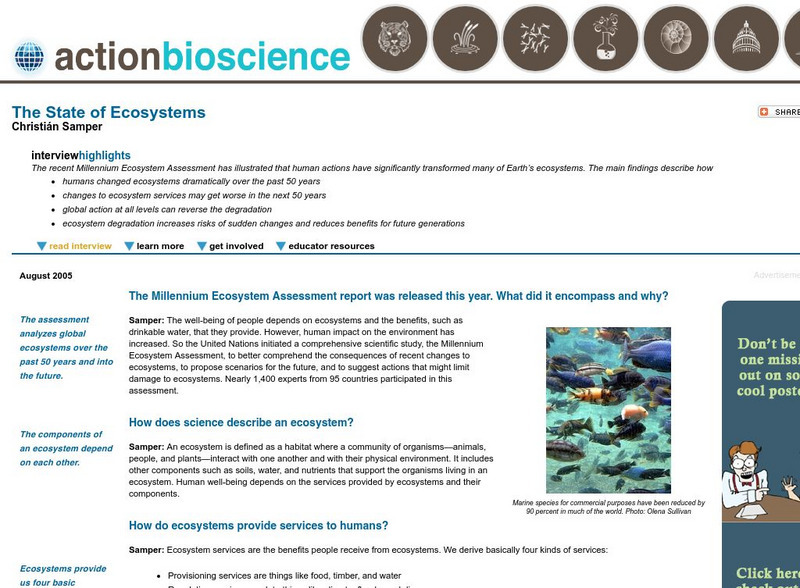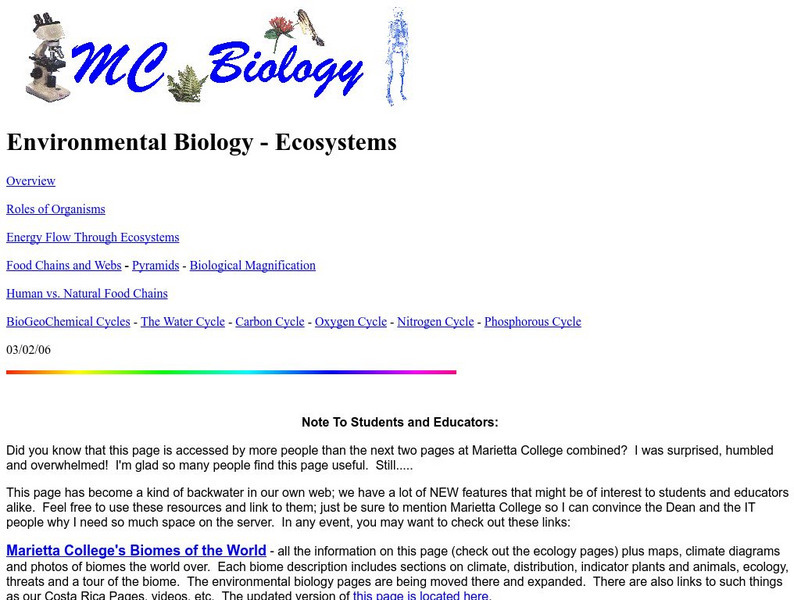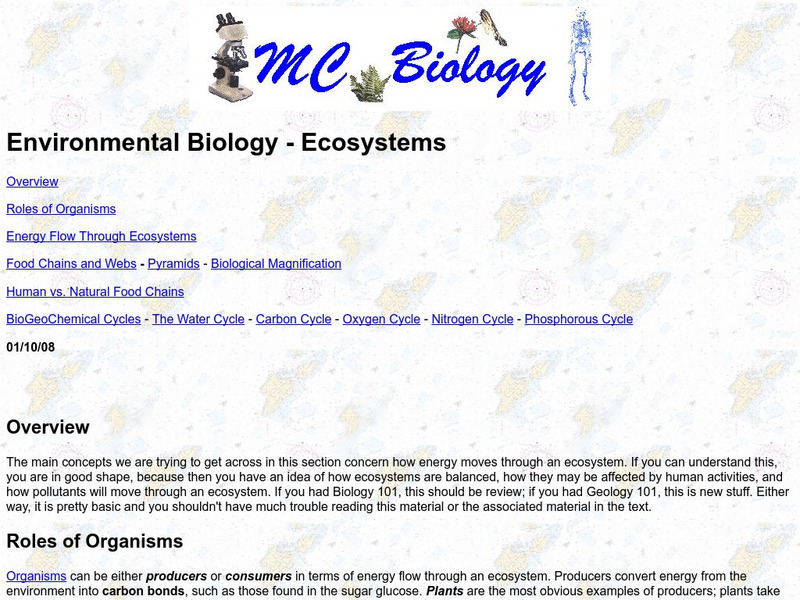Hi, what do you want to do?
Massachusetts Institute of Technology
Mit: Open Course Ware: Ecology: Communities and Ecosystems
This is a collection of courses on communities and ecosystems. Some topics explored are productivity, food webs, and ecology. The courses offer video clips, lecture notes, practice problems, and exam questions. Practice problems and exam...
National Geographic
National Geographic: Sorting the Gulf Ecosystem
In this activity, students sort images of organisms into categories such as birds, reptiles, plants, invertebrates, etc. Next they examine the provided poster of the Gulf of Mexico ecosystem and categorize organisms they identify. A...
National Geographic
National Geographic: Biodiversity in a Wetland Ecosystem
In this lesson, students learn about the biodiversity of a wetlands ecosystem, then focus on the Barataria Preserve near New Orleans. They then research five species that live there, and follow up by trying to identify the land type in...
Nature Conservancy
The Nature Conservancy: Can Fire Positively Impact an Ecosystem?
In this lesson, students explore controlled burn scenarios and the positive impacts of fire on ecosystems.
American Institute of Biological Sciences
Action Bioscience: The State of Ecosystems
Christian Samper details The Millennium Ecosystem Assessment, a report highlighting the detrimental impact of human life on the ecosystems of Earth over the past fifty years. Ecosystems have been deteriorating from a variety of waste and...
CPALMS
Florida State University Cpalms: Florida Students: Changing With the Times: Variation Within Ecosystems
A tutorial investigating how living organisms in an ecosystem are affected by environmental changes.
CK-12 Foundation
Ck 12: Earth Science: Fresh Water Ecosystems Study Guide
Understand fresh water ecosystems using this review guide.
Texas Education Agency
Texas Gateway: Energy and Matter in Ecosystems
Learners analyze food chains, webs, and pyramids to determine how energy flows and matter cycles through ecosystems.
CK-12 Foundation
Ck 12: Earth Science: Flow of Energy in Ecosystems Study Guide
Review the flow of energy through ecosystems with this study guide.
University of California
University of California Berkeley: Ecosystem Equilibrium
A simulator reviewing over the concepts of ecosystem equilibrium.
Other
Marietta College: Ecosystems
Complete illustrated discussion of energy flow within ecosystems, including discussions of trophic levels, ecological pyramids, food chains and webs, biological magnification, and cycles.
Other
Marietta College: Biology: Energy Flow Through the Ecosystem
Read to understand how energy and inorganic nutrients flow through a food chain in an ecosystem.
Science Struck
Science Struck: Understanding the Ocean Ecosystem
Describes the two organisms capable of photosynthesis in an ocean ecosystem, the different ocean zones and the plants and animals that live in them, some facts about the ocean, and the five oceans of the world.
US Environmental Protection Agency
Epa: Climate Change: Plants, Animals, and Ecosystems
Find out how plants and animals adapt to changes in ecosystems.
TeachEngineering
Teach Engineering: Environments and Ecosystems
Young scholars explore the biosphere and its associated environments and ecosystems in the context of creating a model ecosystem, learning along the way about the animals and resources. Students investigate different types of ecosystems,...
Smithsonian Institution
Smithsonian National Zoo: Zoogoer Magazine: Wolves Change an Ecosystem
Jim Robbins's article, "Weaving A New Web: Wolves Change An Ecosystem" focuses on the research and findings of biologist Robert Crabtree and his organization, Yellowstone Ecosystem Studies, in looking at wolves and coyotes.
Oswego City School District
Regents Prep: Ecosystems/communities
Abiotic factors vary in the environment and determining the types and numbers of organisms that exist in that environment. Factors which determine the types and numbers of organisms of a species in an ecosystem are called limiting...
University of Texas at Austin
Univ. Of Texas: Texas Memorial Museum: Creating a Freshwater Ecosystem [Pdf]
An activity where students create a mobile that represent a freshwater ecosystem that appears in nature. Requires Adobe Reader [PDF].
Other
My Science Box: Ecosystem Organization
In this lesson, learners will learn about the different levels in the hierarchy of ecology and explain the relationships: organism, population, community, ecosystem, biome, and biosphere. They will also discover why different regions...
Climate Literacy
Clean: Climate Change and Ecosystems
Young scholars research the inter-dependencies among plants and animals in an ecosystem and explore how climate change affects those relationships and the ecosystem as a whole.
The Wonder of Science
The Wonder of Science: Ms Ls2 4: Ecosystem Interactions and Dynamics
Work samples, phenomena, assessment templates, and videos that directly address standard MS-LS2-4: ecosystem interactions and dynamics.
The Wonder of Science
The Wonder of Science: Ms Ls2 2: Interdependent Relationships in Ecosystems
Work samples, phenomena, assessment templates, and videos that directly address standard MS-LS2-2: interdependent relationships in ecosystems.
The Franklin Institute
Franklin Institute: Ecosystems, Biomes, and Habitats
This site is provided for by The Franklin Institute Online. "Open the door and step into your ecosystem." Content describes ecosystems and related material such as biomes, habitats, energy cycle, extinction, recycling, and more.
Curated OER
National Park Service: Moon Crater Ecosystems Lesson Plan
This is a teacher's guide to a lesson on ecosystems. The objective is for the students to set up their own ecosystem and define the roles of producers, consumers and scavengers.
Other popular searches
- Ecosystems and Biomes
- Pond Ecosystem
- Ecosystems Activities
- Aquatic Ecosystems
- Freshwater Ecosystems
- Ecosystem Food Webs
- Ecosystems in a Jar
- Ocean Ecosystems
- Ecosystem Bottle
- Components of an Ecosystem
- Biodiversity and Ecosystems
- Temperate Forest Ecosystem





















